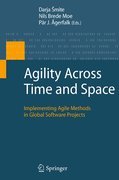
Agility across time and space: implementing agile methods in global software projects
Smite, Darja
Brede Moe, Nils
Agerfalk, Pär J.
Rather than deciding whether or not to get involved in global sourcing, many companies are facing decisions about whether or not to apply agile methods in their distributed projects. These companies are often motivated by the opportunities to solve the coordination and communication difficulties associated with global software development. Yet while agile principles prescribe close interaction and co-location, the very nature of distributed software development does not support these prerequisites. Šmite, Moe, and Ågerfalk structured the book into five parts. In “Motivation” the editors introduce the fundamentals ofagile distributed software development and explain the rationale behind the application of agile practices in globally distributed software projects. “ Transition” describes implementation strategies, adoption of particular agile practices for distributed projects, and general concepts of agility. “Management”details practical implications for project planning, time management, and customer and subcontractor interaction. “Teams” discusses agile distributed team configuration, effective communication and knowledge transfer, and allocation of roles and responsibilities. Finally, in the “Epilogue” the editors summarize all contributions and present future trends for research and practice in agile distributed development. This book is primarily targeted at researchers, lecturers, and students in empirical software engineering, and at practitioners involved in globally distributed software projects. The contributions are based on sound empirical research and identify gaps and commonalities in both the existing state of the art and state of the practice. In addition, they also offer practical advice through many hints, checklists, and experience reports. Questions answered in this book include: What should companies expect from merging agile and distributed strategies? What are the stumbling blocks that prevent companies from realizing the benefits of the agile approach in distributed environments, and how can we recognize infeasible strategies and unfavorable circumstances? What helps managers cope with the challenges of implementing agile approaches in distributed software development projects? How can distributed teams survive the decisions taken by management and become efficient throughthe application of agile approaches? Combines two important trends in software development: how to use agile methods to resolve the inherent communication problems of global teams Based on both empirical research and industrial practice Offers substantial practical advice through many hints, checklists, and experience reports INDICE: Part I Motivation. - 1 Fundamentals of Agile Distributed Software Development. - Part II Transition. - 2 Implementing Extreme Programming in Distributed Software Project Teams: Strategies and Challenges. - 3 Transitioning from Distributed and Traditional to Distributed and Agile: An Experience Report. - 4 Tailoring Agility: Promiscuous Pair Story Authoring and Value Calculation. - 5 Scrum and Global Delivery: Pitfalls and Lessons Learned. - 6 Onshore and Offshore Outsourcing with Agility: Lessons Learned. - 7 Contribution of Agility to Successful Distributed Software Development. - 8 Preparing your Offshore Organization for Agility: Experiences in India. - Part III Management. - 9 Improving Global Development Using Agile. - 10 Turning Time from Enemy into anAlly using the Pomodoro Technique. 11 MBTA: Management By Timeshifting Around. - 12 High Level Planning in Distributed Agile Software: An Action Research Study. 13 Tools for Supporting Distributed Agile Project Planning. - 14 Standing in the Shadow of a Dinosaur: Customer Communication Challenges in Distributed Development Between a Traditional and Agile Organization. - 15 Coordination Between Global Agile Teams: From Process to Architecture. - 16 Considering Subcontractors in Distributed Scrum Teams. - Part IV Teams. - 17 Using Scrum Practices in GSD Projects. - 18 Feature Teams: Distributed and Dispersed. - 19 Roles and Responsibilities in Feature Teams. - 20 Getting Communication Right: the Difference Between Distributed Bliss or Miss. - 21 A Task-Driven Approach onAgile Knowledge Transfer. - 22 Architecture-Centric Development in Globally Distributed Projects. - 23 Agility Across Time and Space: Summing up and Planning for the Future.
- ISBN: 978-3-642-12441-9
- Editorial: Springer
- Encuadernacion: Cartoné
- Páginas: 300
- Fecha Publicación: 01/05/2010
- Nº Volúmenes: 1
- Idioma: Inglés
